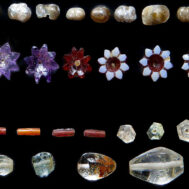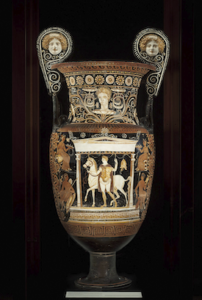
Apulian Volute-krater Attributed to the Virginia Exhibition Painter. Formerly Fordham University Collection inv. 8.001. Image Courtesy of Fordham University.
The Manhattan District Attorney’s Antiquities Trafficking Unit’s aggressive campaign against antiquities traders and collectors has focused in on yet another target, just in time for the U.S. State Department to argue that looting is still a serious threat to Italy’s cultural heritage – even if the looting took place decades before. The Cultural Property Advisory Committee at the State Department will hear a request for at its February 4, 2025 meeting[1] for a sixth 5-year renewal of the Italy-US cultural property agreement[2], in place since 2001.[3] The public is encouraged to comment.[4]
This time the Manhattan DA has elbowed its way into the press cycle with claims of bad provenance and phony documentation going back to the 1980s and ending almost 20 years ago. The alleged threat to public safety is septuagenarian Edoardo Almagià. Almagià, a U.S. born, Princeton-educated antiquities dealer now living in Italy. The charges against Almagià are based on sales and donations of antiquities that took place decades ago. Similarly stale claims against the dealer were abandoned by Italian prosecutors in 2011 and again in 2016, when a criminal prosecution in Italy against Almagia was closed: he was never indicted.[5]
The fact that the supposedly victimized source country has dismissed all claims against an art dealer does not faze Assistant DA Matthew Bogdanos in the least. Nor does any question of the sufficiency of 25-40 year old evidence. Bogdanos’ blanket pronouncement when interviewed by the Princeton Alumni Weekly was, “If Almagià is the first name on your provenance, it is stolen.”
The DA’s warrant states that Edoardo Almagià collaborated with Mauro Morani, an alleged tomb raider, to traffic looted artifacts. Between 1984 and 2001, Almagià reportedly donated, lent, and sold 26 antiquities looted by Morani, valued at over $450,000, to the Princeton University Art Museum. Approximately 30 years later, in 2023, the Manhattan District Attorney’s office seized ten of these antiquities. Another two objects were later returned by the museum. As of late September 2024, 16 artifacts tied to Almagià remain in the University Art Museum, despite the museum’s attempts to return some of them to an uncooperative Italian government.
The New York warrant for Almagia’s arrest also accuses retired Princeton Museum curator J. Michael Padgett of providing “complicit assistance” to Almagià. A criminal investigation in Italy against the curator was dismissed in 2015.[6] The New York warrant alleges that Padgett facilitated connections between Almagià and other prominent figures and institutions in the art world. However, Padgett has denied any wrongdoing, telling the New York Times that he “was not criminally complicit with Edoardo Almagià or anyone else.”[7]
Cases Against Almagià and other dealers
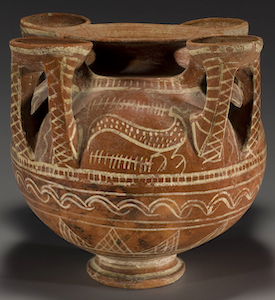
Etruscan White-on-Red Kernos. Formerly Fordham University Collection inv. 5.010. Image Courtesy of Fordham University.
Almagià cannot claim altogether clean hands: In 2000, he was detained at John F. Kennedy Airport after attempting to import two allegedly stolen Italian frescoes, and authorities intercepted a shipment of five undocumented Italian antiquities en route to New Jersey. In 2006, Italian officials arrested Almagià on charges of receiving and illegally exporting stolen artifacts. While the charges were ultimately dismissed, an Italian court still issued a request for the confiscation of his artifacts. Almagià waves this past history away. Interviewed by the Princetonian (Almagià is a Princeton alumnus, ’73) he stated, “This is absolutely ridiculous… We are getting to the point that whenever you touch an antiquity, you are a crook.”
The charges against Almagia were set forth in an 80-page warrant issued by a NY court at the end of November at the request of the Manhattan DA. The DA’s next step may be to ask Interpol to issue a Red Notice asking Italian authorities to detain Almagià and then to seek his extradition to the U.S.
The Almagià case once again raises questions about retroactively enforcing foreign countries’ claims to national ownership of objects acquired at a time when neither source countries nor the U.S. enforced such laws.
Like other antiquities cases pursued by the Manhattan District Attorney, much of the evidence hinges on hearsay and fragmentary documentation. The allegations, based on transactions from the 1980s through early 2000s, involve the illicit trade of archaeological artifacts. These prosecutions come despite earlier agreements between Italy and U.S. museums and collectors that were intended to resolve future disputes over looted antiquities and foster collaboration, including loans of significant antiquities. Why is the Manhattan District Attorney’s office targeting elderly dealers and retired curators for actions taken long ago? Could it be that having built his reputation on wildly exaggerated arguments that the antiquities market is a billion-dollar criminal enterprise, Bogdanos has been unable to find evidence of crimes taking place in New York today? Instead, he appears to be looking further and further back – to the 30s, 40s and 50’s – and hunting down artifacts from California, Illinois, and Ohio museums – far from the confines of New York County, his actual jurisdiction.
Critics of the DA’s actions argue that this campaign retroactively applies modern ethical standards to practices common and accepted in the 20th century, raising questions about fairness, historical context, and institutional responsibility.
A Debonair Dealer in Antiquities
Edoardo Almagià, a charismatic figure in the antiquities world, began his career in the 1980s, dealing in Roman sculptures, Etruscan pottery, and other artifacts often acquired from European markets or free ports. Since that time, objects that passed through Almagià’s hands entered U.S. collections and were donated or sold to museums like the Princeton University Art Museum, the Cleveland Museum of Art, and the Getty.
Almagià insists that at this time, provenance and legal considerations were secondary to the aesthetics and academic value of objects. “Do you think I was the only one buying from the free port?” he asked in an interview with Princeton Alumni Weekly. “Everybody was doing it.”
From Ara Pacis palace to Ara Pacis Carabinieri Exhibition

Ara Pacis Augustae. Altar in Rome dedicated to Pax, Roman goddess of Peace. Museum of the Ara Pacis, Rome. Photo Rabax63, 17 November 2017, CCA-SA 4.0 Int’l. license.
When this author was in Rome a few years ago, the Italian cultural ministry was organizing a new Museum of Rescued Art, “to showcase the success of Italy’s diplomatic efforts to repatriate antiquities from foreign museums and private collections abroad” – a policy effectuated by visiting Carabinieri chiefs who not too subtly pointed out to museum directors that Marion True of the Getty was not the only curator who might be prosecuted for antiquities crimes. As the new museum was still closed to the public, I was surprised to find a sampling of its collection in a very small gallery, unlisted among the museum exhibits, in the basement of the Ara Pacis, behind a larger exhibition on the history of Roman law. When I stepped into the 12 x 15 ft space, I saw a dozen of the top pieces seized from Fordham University in vitrines along the walls.
One could hardly miss the irony in this, as an earlier Princeton interview by W. Barksdale Maynard with Edoardo Almagià had elicited the following:
Maynard: The famous Ara Pacis from ancient Rome was discovered under the Palazzo Fiano Almagia a century ago – this was your family?
Almagià: The Ara Pacis was found under my family’s palace, and the expense of excavating it was underwritten by us. Later we lost everything because of the fascist regime, which stole everything. My father was kicked out of Italy in 1939. He lived many years in America and was an admirer [of the United States]. When he died, I decided to move to the U.S. [in the 1980s]. I lived in New York and found antiquities again, as a dealer.
The Green Book and Its Consequences
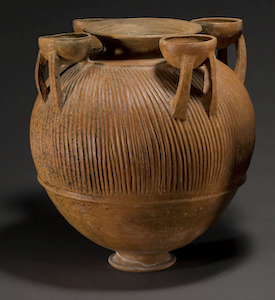
Olla With Four Trays from Lazio. Formerly Fordham University Collection inv. inv. 2007.1.3. Image Courtesy of Fordham University.
The Manhattan District Attorney’s Antiquities Trafficking Unit, led by Assistant DA Matthew Bogdanos, alleges that Almagià was central to a decades-old network of trafficking looted antiquities. The DA’s case relies heavily on the so-called “Green Book,” a ledger allegedly found during a 2006 raid of Almagià’s New York apartment. The book reportedly lists nearly 1,700 artifacts, their prices, and connections to alleged tomb raiders.[8]
While Almagià acknowledges the book’s existence, he disputes its interpretation. “The Green Book is simply a record of my transactions, many of them entirely legitimate,” he contends. He also maintains that much of the material listed was bought from well-known dealers or open markets in Switzerland, London, and Rome, where looting accusations were not part of the public discourse.
Rewriting the Rules of Collecting
Critics of the DA’s aggressive pursuit of Almagià argue that the investigation retroactively enforces contemporary ethical standards on practices that were widely accepted in the 20th century. During that era, cultural property laws were evolving, but many source countries did not actively enforce their ownership claims or pursue restitution.
Jessica Powers, a curator of the ancient Mediterranean collection at the San Antonio Museum of Art, articulated a key concern. “These objects were acquired when standards of provenance were not what they are now,” she noted. “We don’t wholesale offer restitution of everything handled by Dealer X without clear evidence of wrongdoing.”
Notably, some of Almagià’s key patrons included individuals in positions of legal authority. One prominent donor to the Fordham Museum of Greek, Etruscan, and Roman Art—William D. Walsh – where Almagià’s antiquities represented one-third of the collection—was himself a federal prosecutor.[9] The donor collected in the same era as Almagià, further highlighting the widespread acceptance of these practices.
Museums in the Crosshairs
Museums have borne the brunt of the DA’s campaign, with seized artifacts casting shadows over institutional legacies. Princeton University, Almagià’s alma mater, returned six items to Italy in 2011 and had six more seized in 2023. Critics argue that the university failed to act proactively, despite repeated scrutiny of Almagià’s dealings.
Others, like the Fordham Museum, faced substantial losses. Jennifer Udell, Fordham’s curator of university art, described the impact of losing nearly a third of the collection. “It’s frustrating because these objects were acquired with care for their educational value,” she said. “Now we’re left re-configuring our museum, while artifacts sit in Italian storage.”
Is Repatriation Always the Answer?
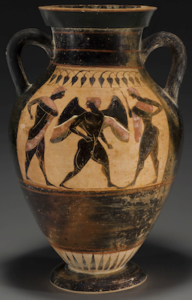
Athenian Black-figured Amphora Attributed to the Swing Painter. Formerly Fordham University Collection inv. 4.022. Image Courtesy of Fordham University.
The DA’s unit has successfully repatriated thousands of artifacts to Italy, but the broader question of cultural stewardship remains unresolved. Almagià argues that many objects he sold hold little unique significance to their countries of origin. “Frankly, whether Italy has one more or one less red-figure vase doesn’t make a difference,” he said. “They are left to rot in warehouses, unseen and unappreciated.”
This perspective is not without precedent. Museums historically justified acquisitions by asserting they could preserve and showcase artifacts better than underfunded institutions in source countries. Almagià continues to question the utility of removing artifacts from well-curated collections.
“There are objects in U.S. museums that are undoubtedly stolen from excavations but when they are not objects of the greatest importance, I think they should remain there so they can be appreciated by American visitors.” [10] “If an object is appreciated and studied in an American museum, isn’t that a better fate than sitting in a crate?”
Deliberate Denial of Key Information to Museums and Collectors
There is a lengthy history of requests for information about allegedly looted objects from museums, auction houses, art dealers and collectors that have gone unanswered. In their 2011, 2015 and 2020 submissions regarding renewal of the U.S. State Department’s Memorandum of Understanding (MOU) with Italy, the submitters repeatedly asked for greater transparency from the Italian government and raised significant concerns about Italy’s lack of follow-through on its promises of collaboration. The Association of Art Museum Directors and others explicitly pointed out issues such as Italy’s failure to release the Gianfranco Becchina dossier, and records from investigations into other antiquities dealers, such as Edoardo Almagiá, Robin Symes, Robert Hecht, and Giacomo Medici. These archives include a trove of documents, photographs, and objects seized by Italian investigators during criminal investigations into antiquities trafficking enterprises.
Despite being decades old and from cases that have long been closed, this evidence remains inaccessible to the public and the museum and art community. Italy has chosen instead to selectively share information from these archives with archaeologists, with the Manhattan District Attorney’s Office, and even with self-described “antiquities hunters.” This information has been utilized to expose objects connected to these archives when they appear in museums, private collections, or auctions. However, the information is deliberately withheld from the objects’ owners, including museums and legitimate art dealers, depriving them of the opportunity to identify, investigate, and return suspect objects on their own. Italy’s refusal to provide information has caused unnecessary embarrassment for U.S. museums and the legitimate art trade. It results in sensationalist and misleading headlines that damage trust and collaboration between Italy and the international art community. By selectively withholding critical information, Italy is undermining its own reputation as a reliable steward of cultural heritage, further straining relationships with museums and art institutions globally.
An Antiquities Trade Under Siege
The Manhattan DA’s Antiquities Trafficking Unit, created in 2017, has gained a reputation for its aggressive approach. While its efforts have returned over $260 million worth of artifacts to 25 countries, critics say the unit often disregards historical context and the practicalities of acquisition during earlier decades.
Even as Almagià faces potential extradition and charges, questions linger about the efficacy of the DA’s campaign. Does retroactively enforcing today’s standards erase the complexities of antiquities trade history, or does it pave the way for overdue accountability? For museums and collectors, the fallout has exposed vulnerabilities in provenance research and forced a reckoning with their collections.
Cultural Preservation or Overreach?
The debate over Almagià’s culpability is emblematic of larger tensions in the art world. Advocates of the DA’s actions frame it as a necessary correction to an era of unchecked looting. Yet others argue that such prosecutions unfairly scapegoat individuals like Almagià while ignoring systemic complicity.
Almagià remains unrepentant. “The market has been criminalized,” he lamented. “What I did was what everyone else did…” “…in Italy hundreds of thousands of people… have antiquities at home. They might have inherited them or bought them. In my youth, there were flea markets, and you could buy every antiquity you wanted. All those people that bought things – are they all criminals?”[11]
According to the Manhattan DA, the answer lies in an evolving understanding of cultural heritage and the lasting legacy of the antiquities trade. The actual history of the art trade points instead to an almost complete lack of enforcement of foreign antiquities laws until the 1980s or much later, depending on the foreign nation, and to willful blindness or complicit participation by foreign officials. If the public ever requires greater transparency and accountability of the Manhattan DA’s office then it may turn out that other factors – personal ambition and a willingness to take legal shortcuts among them – may also be threatening U.S. museum collections.
Notes (updated 01-04-25)
[1] Cultural Property Advisory Committee Meeting, Federal Register, 12/30/2024, https://www.federalregister.gov/documents/2024/12/30/2024-31255/cultural-property-advisory-committee-meeting
[2] Proposal to Extend the Cultural Property Agreement Between the United States and Italy, Federal Register, 12/30/2024, https://www.federalregister.gov/documents/2024/12/30/2024-31257/proposal-to-extend-the-cultural-property-agreement-between-the-united-states-and-italy
[3] The first authorized import restrictions on Italian cultural artifacts from the Pre-Classical, Classical and Imperial Roman periods in 2001. The restrictions were extended 2006 and again in 2011, 2016, and 2021. The 2011 renewal added new import restrictions on Greek, early Republican and Provincial coins from the early Imperial Period. Coin types from the later Roman Republic (post 211 BC) and Roman Imperial Coins were excluded from any import restrictions. There is serious concern that restrictions may be expanded to include Roman Imperial coins in the upcoming MOU, since restrictions have been imposed on Roman Imperial coins on behalf of Afghanistan, Egypt, Pakistan and Ukraine despite evidence being presented that comparatively few such coins are found in these countries. See Peter K. Tompa, Please Help Save Roman Imperial Coin Collecting (and Express Concerns about Current or Possible Restrictions on Other Coins from Chile, Italy, Morocco, and Vietnam), December 31, 2024, http://culturalpropertyobserver.blogspot.com/2024/12/please-help-save-roman-imperial-coin.html.
[4] Cultural Property Advisory Committee Meeting, February 4-6, 2025, https://eca.state.gov/highlight/cultural-property-advisory-committee-meeting-february-4-6-2025. The Cultural Property Advisory Committee will meet February 4-6, 2025 to review a new request for cultural property import restrictions from Vietnam, and to review the proposed extensions of the cultural property agreements with Chile, Italy, and Morocco. The public may provide written comment by January 27, 2025 in advance of the meeting and/or register to speak in the virtual open session scheduled for February 4, 2025, at 1:00 p.m. EST. Registered participants can speak and may be asked questions by the Committee. If you wish to register to speak you must submit your name and organizational affiliation in an email request to culprop@state.gov by January 27, 2025.
[5] Colin Moynihan, Investigators Say a High-Profile Dealer Trafficked 2,000 Looted Artifacts, NYT, Oct 31, 2024, https://www.nytimes.com/2024/10/31/arts/design/looted-artifacts-charges-edoardo-almagia.html
[6] Mark F. Bernstein, Curator no longer part of probe, Princeton Alumni Weekly, January 21, 2016, https://paw.princeton.edu/article/curator-no-longer-part-probe
[7] Supra note 5.
[8] Supra, note 5.
[9] It is noteworthy that this fact was not mentioned in the extensive discussion of Walsh’s and others culpability for irresponsible collecting of the Seizures from Fordham University in Gill DWJ. Learning and Knowledge Loss: Returning Antiquities from Fordham University to Italy. International Journal of Cultural Property. 2024;31(1):28-61. doi:10.1017/S0940739124000092
[10] Tom Mashberg, A Trove of Artifacts Officials Call ‘Stolen’ Are Returned to Italy, NYT, December 15, 2021, https://www.nytimes.com/2021/12/15/arts/design/antiquities-repatriated-district-attroney.html
[11] W. Barksdale Maynard, Italy’s antiquities and U.S. Museums: A Q&A with Edoardo Almagià ’73, Princeton Alumni Weekly, July 7, 2010, https://paw.princeton.edu/article/italys-antiquities-and-us-museums-qa-edoardo-almagia-73
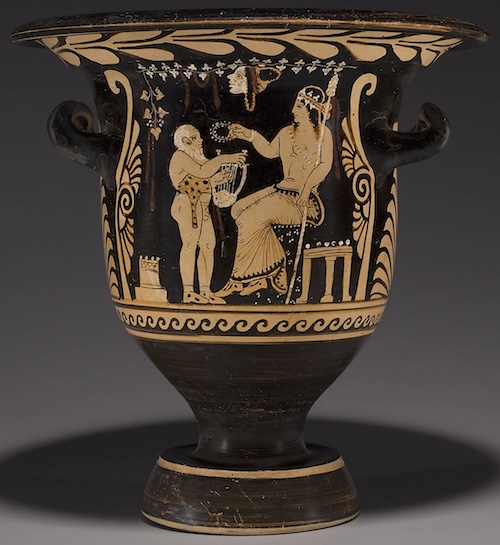 Paestan Red-figured Bell-krater Attributed to Python. Formerly Fordham University Collection inv. 4.005. Image Courtesy of Fordham University.
Paestan Red-figured Bell-krater Attributed to Python. Formerly Fordham University Collection inv. 4.005. Image Courtesy of Fordham University. 

